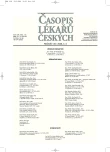Paranoid Syndrome, Paranoid Reaction, Paranoia
Authors:
P. Pavlovský
Authors‘ workplace:
Psychiatrická klinika 1. LF UK a VFN, Praha
Published in:
Čas. Lék. čes. 2006; 145: 178-180
Category:
Review Article
Overview
The term paranoid is derived from the Greek word paranoia meaning nadnese. It does not only mean self-reference, but there are various personality features as they are hostility, a tendency towards aggressiveness, irritability, a lack of sense of humour, feelings of overestimation of one-self and a tendency towards accusations. These features may appear also within normal psychology and they becomeclinically important after thein increase of intensity and conspicuousness (los sof hearing, long-term abuse of alcohol and psychostimulants) and organic disorders of the brain may contribute to the development of paranoidity. A mechanism of projection is considered as a decivise factor from the point of view of dynamic psychiatry. Clinically unimportant sign sof paranoidity can be observed due to unusual situations. If a paranoid reaction becomes more serious, formation of a paranoid delusion should be taken to account. In our koncept the term paranoid and paranoidity should be used only as a psychopathological term.
Key words:
paranoid syndrome, development of paranoia, biological cause of paranoidity, mechanism of projection, formation of delusion, paranoid disorders in ICD-10.
Labels
Addictology Allergology and clinical immunology Angiology Audiology Clinical biochemistry Dermatology & STDs Paediatric gastroenterology Paediatric surgery Paediatric cardiology Paediatric neurology Paediatric ENT Paediatric psychiatry Paediatric rheumatology Diabetology Pharmacy Vascular surgery Pain management Dental HygienistArticle was published in
Journal of Czech Physicians

Most read in this issue
- Paranoid Syndrome, Paranoid Reaction, Paranoia
- Chronic Post-mastectomy Pain
- Percutaneous Sacroplasty in Sacral Insufficiency Fracture Treatment
- Development of Incidence of Post-dural Puncture Headache in Patients Undergoing Caesarean Section in Spinal Anaesthesia at the Department of Obstetrics and Gynecology in Olomouc during 2003–2004
